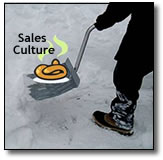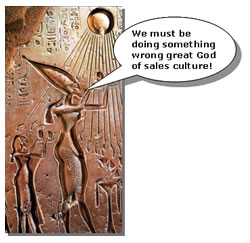Happy New Year, Gonzomongers! It’s 2009 and everyone is still taking stock on the damage and repairs after the “October tsunami” that ended a wild, 15-year era in banking. Now, as we sweep up the broken glass, bankers are beginning to reflect on what’s in store for the next chapter in our industry. It’s a time to remember what’s fundamental to our business and a time to shed outdated assumptions and try new things.
 As bankers start to plant these seeds of renewal during 2009, I’m hopeful we’ll take a hard look at the pile of dung our industry has built around the dogma of “sales culture.” I’m hopeful we’ll grab the snow shovel, throw the dung in the dumpster and finally get real about how bankers create value for customers.
As bankers start to plant these seeds of renewal during 2009, I’m hopeful we’ll take a hard look at the pile of dung our industry has built around the dogma of “sales culture.” I’m hopeful we’ll grab the snow shovel, throw the dung in the dumpster and finally get real about how bankers create value for customers.
I think a great portion of the time, money and effort spent on sales culture over the past 15 years has been a misguided waste. In many respects, “sales culture” has become a false idol. We pin our hopes and undying loyalty to the god, and,  when the god doesn’t bring rain (or revenue growth) we conclude that we just haven’t been pious enough for the great deity. Across the country, many banks have 10+ years of effort on sales culture without significant improvement in results, but they fail to question if they are even building the right mouse trap.
when the god doesn’t bring rain (or revenue growth) we conclude that we just haven’t been pious enough for the great deity. Across the country, many banks have 10+ years of effort on sales culture without significant improvement in results, but they fail to question if they are even building the right mouse trap.
In the name of healthy skepticism, I believe banks have made five critical mistakes with how they designed sales cultures:
Mistake #1: Banks have struck an arrogant and alienating tone with front-line employees
I have seen too many banks talk about their front-line people like they are doltish, change-resistant annoyances who are too “reactive” and unwilling to be “proactive” with sales. How many armies ever gladly stormed the hill when their leaders used such a condescending tone? What’s interesting is that many folks who criticize the lack of sales prowess on the front line are managers or staffers who have never demonstrated their own individual sales performance. Going forward, banks need to shut up the academic pontificators and demand that any sales culture be led by example. I talked to a CEO the other day who brought in a $25 million account during the holidays she had been working all year long. That’s what I’m talking about!
Mistake #2: Banks have been naïve with the “customer profiling” processes
Somehow our industry’s misguided sales model is built upon some utopian customer encounter that never actually occurs in the real world. The theory goes like this:
- Busy customer with unlimited financial choices stumbles into your branch with a financial need (maybe it was destiny?).
- Dynamic sales rep refuses to only fulfill the client’s request and instead asks the customer to help her fill out a three-page, six-point font “Customer Profile Form.”
- Fantasy-land customer says he appreciates turning a 15-minute request into a 45-minute root canal and emphasizes the he enjoys disclosing any private information the platform rep deems appropriate.
- Based upon this profile, a highly skilled and educated sales professional suggests an additional 26 products that the customer needs, and the customer gladly accepts the offer.
- The song “Dream Weaver” by Gary Wright starts to play, the clouds part in the sky and the sun beams upon a customer who says he’s been waiting all his life for a real financial relationship. The banker’s heart is warm, knowing he will report a 27.5 cross-sell ratio.
If any member of any of our families would be interested in a financial encounter like the one described above, I would buy you one HUGE beer. But come on, we know our family members. They’d be bickering at the barbeque that the bank was slow, cumbersome and “just trying to sell me something.” We can spend another 15 years trying to build this experience or we can admit this it’s a misguided solution that people will never buy into.
Mistake #3: Banks have inadequate employee knowledge necessary to earn relationships
It’s too bad we’ve spent more than a decade filling our bankers’ heads with sales process, calling sheets and goal demands when we could have been filling their heads with knowledge about financial products and services. Let’s be honest – do any of us really believe the average CSR in banking could pass any written test that would qualify them to give sound advice about household finance? That’s not their fault, it’s ours.
Bank executives have paid lip service to training, development and certification efforts to make our front-line staff true professionals. Instead of professionals, we’re breeding khaki-wearing sales grunts with limited abilities to really help customers make better financial choices. Ever been wowed at the Apple Genius Bar by what a 22-year-old knows about iPhones, iMacs and digital photo editing? Where is the equivalent of this in banking?
Mistake #4: Banks have paid inadequate attention to servicing and fulfillment processes
While the retail banking industry has focused on sales culture, not enough tenacity has been directed at making customer fulfillment and service processes fast and simple. It’s almost surreal for branch customers when a stilted cross-sell pitch comes in the middle of a painstakingly incompetent customer service process. When our firm, Cornerstone Advisors [2], reviews bank delivery systems, we often conclude that the “silent killer” of revenue growth and cross-sell is simply mediocre service and fulfillment capabilities.
Mistake #5: Retail “profit improvement” tactics have undermined “share of wallet” goals
Enough has been written about our industry’s desperate attempts to shore earnings up with fee gouging. These tactics that improved fee income in the short term have also completely undermined a company’s ability to brand itself as a concerned advocate for the customer.
THE NEXT CHAPTER OF SALES CULTURE
I am hopeful that our industry will stop the madness on the sterile, rote approach we’ve taken toward sales culture. Why not step back and design our sales and delivery like we know our family members really want it to be. In this redesign process, I would offer five key design principles.
#1: Relationships must translate into fast and easy fulfillment
If we want to promote the benefits of having a broader relationship with clients, we damn well better make it easy to get the next loan, deposit or investment product. Ask yourself, “How are we using customer information to make additional product openings, renewals and modifications fast, simple and utterly painless for the customer?”
#2: Knowledge must be emphasized over sales tactics
Winning banks will realize that sales process without knowledge simply gives folks the creeps. They will finally equip their front line with the knowledge to answer basic questions of household finance, and they will have the operational knowledge to quickly answer any question or fulfill any request.
#3: Promoting delivery is just as important as selling product
When banks talk about promoting their offerings and building customer loyalty, they have to recognize that selling channels (Internet, debit, mobile, bill pay, e-statement) is just as critical as selling the next deposit or loan account. Think how easy financial life is for the typical “power user” of electronic delivery channels, and then estimate how many of your bank customers could be power users but just haven’t had the appropriate information, coaching and prodding to get them up to speed. Banks that focus on helping their clients become delivery power users are certain to build loyalty. Final question: what percentage of your front-line employees are delivery channel power users today who can lead by example?
#4: Trust must be earned before “profiling” a customer
My partner at Cornerstone, Terence Roche, wishes all compulsory customer profiling sheets across the industry would be ripped up and the process dumped permanently. Instead, bankers should work to build trust with the client by being knowledgeable, fast and effective. Over time, bankers can painlessly accumulate this type of profile information through natural relations with the client. In addition, instead of putting the customer to work, banks should focus on better leveraging data that already exists in the mortgage and consumer loan applications and commercial loan write-ups throughout the bank.
#5: Advocates will win over the sneaky
Several years ago, Forrester Research created some outstanding work along the concept of customer advocacy. Consumers were asked to rate their financial service provider according to how well they balanced the customer’s best interests with the company’s own profit motivations. As one would expect, most big banks place dismally low in Forrester’s customer advocacy scores [4], while the service and principle-driven USAA has received Forrester’s highest score the past four years running.
Now that many large retail banks lie in waste, I believe we will see the emergence of many more advocacy-based competitors who will understand how well this approach plays into revenue growth and sales. As Lennon and McCartney so aptly stated, “And in the end, the love you take is equal to the love you make.”
In case anyone hasn’t noticed, the finances of the average American family are in complete disarray. People are stressed, confused and downright scared. They could use a financial company that sincerely wants families to dig out of this. (I would site Arkadi Kuhlman at ING [5] as one of these folks.) They want an honest, straight-shooting bank with smart people and no hassles. It’s pretty simple. By the way, not one American family is looking for a customer profiling sheet or a cross-sell goal or a 45-minute branch encounter.
So, GonzoBankers, an era is over, but a new chapter of bank sales cultures is about to begin. Common sense tells us we have the chance to get it right this time.
–sw